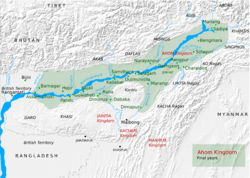Kingdom of Assam
| Ahom kingdom | ||||||||||
| আহোম ৰাজ্য | ||||||||||
|
||||||||||
|
The Ahom kingdom. Circa 1826. The kingdom was founded by Sukaphaa between the Dikhau and the Dihing rivers in the 13th century, and by the end of the 19th century, the western outpost was the Assam Choki, or Hadira Choki, contiguous with British territories. The southern boundaries was defined by Doboka and Dimapur. The eastern portion around Bengmara, the Matak regions, was under the autonomous control of the Barsenapati. Jorhat became the capital of the kingdom after the Moamoria rebellion.
|
||||||||||
| Capital | Charaideo, Garhgaon, Rangpur, Jorhat | |||||||||
| Languages |
Assamese Tai |
|||||||||
| Religion | Hinduism | |||||||||
| Government | Absolute monarchy with Unitary state | |||||||||
| Sri Srimat Swargadeo Maharaja | ||||||||||
| • | 1228–1268 | Sukaphaa | ||||||||
| • | 1648–1663 | Sutamla | ||||||||
| • | 1811–1818, 1819–1821 | Sudingphaa | ||||||||
| History | ||||||||||
| • | Established | 1228 | ||||||||
| • | Disestablished | 1826 | ||||||||
|
||||||||||
| Today part of | Assam, India | |||||||||
The Ahom kingdom (/ˈɑːhɑːm, ˈɑːhəm/, 1228–1826, also called Kingdom of Assam) was a kingdom in the Brahmaputra Valley in Assam, India, that maintained its sovereignty for nearly 600 years and successfully resisted Mughal expansion in Northeast India. Established by Sukaphaa, a Tai prince from Mong Mao, it began as a mong in the upper reaches of the Brahmaputra based on wet rice agriculture. It expanded suddenly under Suhungmung in the 16th century and became multi-ethnic in character, casting a profound effect on the political and social life in the entire Brahmaputra valley. The kingdom became weaker with the rise of the Moamoria rebellion, and subsequently fell to repeated Burmese invasions of Assam. With the defeat of the Burmese after the First Anglo-Burmese War and the Treaty of Yandabo in 1826, control of the kingdom passed into East India Company hands.
...
Wikipedia


